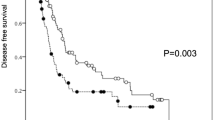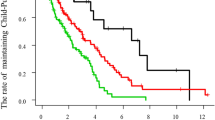Abstract
Background
Transcatheter arterial chemoembolization (TACE) is an effective treatment for hepatocellular carcinoma (HCC), but it sometimes makes liver function worse. The pre-TACE prediction of liver dysfunction after TACE would be helpful to avoid long-term liver dysfunction.
Methods
We performed a case–control study in 100 HCC patients who underwent TACE at Kobe University Hospital. Urinary/blood biochemical examinations were performed before TACE. As an indicator of liver function, Child’s score was also evaluated before and 3 months after TACE. Cases with and without an increase of 2 points or more in the Child’s score were compared, and independent risk factors were statistically examined. A pre-TACE predictive model of an increase of 2 points or more in the Child’s score after TACE was developed using logistic regression.
Results
Univariate analyses showed that des-γ-carboxy prothrombin (DCP) and lactate dehydrogenase (LDH) before TACE were significantly higher in the Child’s score-deteriorated group than in the group with no deterioration (p = 0.036 and 0.003, respectively). All possible multivariate regressions showed that DCP (p = 0.003) and LDH (p = 0.002) were independent factors determining the deterioration of Child’s class. A predictive model was developed, as follows: exp(0.014 × LDH + 0.572 × ln(DCP) − 8.655)/(1 + exp(0.014 × LDH + 0.572 × ln(DCP) − 8.655)). The model discriminated well, with AUC being 0.837 (95 % confidence interval [CI] 0.662–1.000). The optimal cut-off point was 0.073, and the sensitivity and specificity were 90.9 and 69.7 %, respectively.
Conclusions
High values of DCP and LDH before TACE were associated with the long-term deterioration of liver function. Our pre-therapeutic prediction model could be useful to identify high-risk cases.


Similar content being viewed by others
Abbreviations
- HCC:
-
Hepatocellular carcinoma
- RFA:
-
Radiofrequency ablation
- PEI:
-
Percutaneous ethanol injection
- TACE:
-
Transcatheter arterial chemoembolization
- CT:
-
Computed tomography
- DCP:
-
Des-γ-carboxy prothrombin
- IBW:
-
Ideal body weight
- BMI:
-
Body mass index
- TNM:
-
Tumor node metastasis
- AST:
-
Aspartate aminotransferase
- ALT:
-
Alanine aminotransferase
- LDH:
-
Lactate dehydrogenase
- γ-GTP:
-
γ-Glutamyltranspeptidase
- T-Bil:
-
Total bilirubin
- ChE:
-
Cholinesterase
- BTR:
-
Branched-chain amino acid/tyrosine ratio
- PT:
-
Prothrombin time
- Plt:
-
Platelets
- FPG:
-
Fasting plasma glucose
- IRI:
-
Immunoreactive insulin
- HbA1c:
-
Hemoglobin A1c
- HA:
-
Hyaluronic acid
- AFP:
-
Alpha fetoprotein
- ICG:
-
Indocyanine green
- 3-MH:
-
3-Methylhistidine
- CHI:
-
Creatinine height index
- VIF:
-
Variance inflation factor
- AIC:
-
Akaike’s information criterion
- AUC:
-
Area under ROC
- EMT:
-
Epithelial to mesenchymal transition
- BCAA:
-
Branched chain amino acids
References
Parkin DM, Bray F, Ferlay J, Pisani P. Estimating the world cancer burden: GLOBOCAN 2000. Int J Cancer. 2001;94:153–6.
Ryder SD. Guidelines for the diagnosis and treatment of hepatocellular carcinoma (HCC) in adults. Gut. 2003;52:iii1–8.
Bronowicki JP, Vetter D, Dumas F, Boudjema K, Bader R, Weiss AM, et al. Transcatheter oily chemoembolization for hepatocellular carcinoma. A 4-year study of 127 French patients. Cancer. 1994;74:16–24.
Vetter D, Wenger JJ, Bergier JM, Doffoel M, Bockel R. Transcatheter oily chemoembolization in the management of advanced hepatocellular carcinoma in cirrhosis: results of a Western comparative study in 60 patients. Hepatology. 1991;13:427–33.
Mondazzi L, Bottelli R, Brambilla G, Rampoldi A, Rezakovic I, Zavaglia C, et al. Transcatheter oily chemoembolization for the treatment of hepatocellular carcinoma: a multivariate analysis of prognostic factors. Hepatology. 1994;19:1115–23.
Lo CM, Ngan H, Tso WK, Liu CL, Lam CM, Poon RT, et al. Randomized controlled trial of transarterial lipiodol chemoembolization for unresectable hepatocellular carcinoma. Hepatology. 2002;35:1164–71.
Llovet JM, Real MI, Montaňa X, Planas R, Coll S, Aponte J, et al. Arterial embolisation or chemoembolisation versus symptomatic treatment in patients with unresectable hepatocellular carcinoma: a randomised controlled trial. Lancet. 2002;359:1734–9.
Llovet JM, Bruix J. Systematic review of randomized trials for unresectable hepatocellular carcinoma: chemoembolization improves survival. Hepatology. 2003;37:429–42.
Heidelbaugh JJ, Bruderly M. Cirrhosis and chronic liver failure. Part I: diagnosis and evaluation. Am Fam Physician. 2006;74:756–62.
Bismuth H, Morino M, Sherlock D, Castaing D, Miglietta C, Cauquil P, et al. Primary treatment of hepatocellular carcinoma by arterial chemoembolization. Am J Surg. 1992;163:387–94.
Yamada R, Kishi K, Sonomura T, Tsuda M, Nomura S, Satoh M. Transcatheter arterial embolization in unresectable hepatocellular carcinoma. Cardiovasc Intervent Radiol. 1990;13:135–9.
Stuart K, Stokes K, Jenkins R, Trey C, Clouse M. Treatment of hepatocellular carcinoma using doxorubicin/ethiodized oil/gelatin powder chemoembolization. Cancer. 1993;72:3202–9.
Pugh RN, Murray-Lyon IM, Dawson JL, Pietroni MC, Williams R. Transection of the oesophagus for bleeding oesophageal varices. Br J Surg. 1973;60:646–9.
Brown JR, Cochran RP, Leavitt BJ, Dacey LJ, Ross CS, MacKenzie TA, et al. Multivariable prediction of renal insufficiency developing after cardiac surgery. Circulation. 2007;116:I-139–43.
Watanabe D, Suzuma K, Matsui S, Kurimoto M, Kiryu J, Kita M, et al. Erythropoietin as a retinal angiogenic factor in proliferative diabetic retinopathy. N Engl J Med. 2005;353:782–92.
Tan NC, Fisher WG, Rosenblatt KP, Garner HR. Application of multiple statistical tests to enhance mass spectrometry-based biomarker discovery. BMC Bioinformatics. 2009;10:144.
Kudo M, Okanoue T. Management of hepatocellular carcinoma in Japan: consensus-based clinical practice manual proposed by the Japan Society of Hepatology. Oncology. 2007;72:2–15.
Liver Cancer Study Group of Japan. The general rules for the clinical and pathological study of primary liver cancer. Jpn J Surg. 1989;19:98–129.
Blackburn GL, Bistrian BR, Maini BS, Schlamm HT, Smith MF. Nutritional and metabolic assessment of the hospitalized patient. J Parenter Enteral Nutr. 1977;1:11–22.
Pelletier G, Ducreux M, Gay F, Luboinski M, Hagège H, Dao T, et al. Treatment of unresectable hepatocellular carcinoma with lipiodol chemoembolization: a multicenter randomized trial. Groupe CHC. J Hepatol. 1998;29:129–34.
Saito M, Seo Y, Yano Y, Miki A, Yoshida M, Azuma T. Short-term reductions in non-protein respiratory quotient and prealbumin can be associated with the long-term deterioration of liver function after transcatheter arterial chemoembolization in patients with hepatocellular carcinoma. J Gastroenterol. 2012 (in press).
Liebman HA, Furie BC, Tong MJ, Blanchard RA, Lo KJ, Lee SD, et al. Des-gamma-carboxy (abnormal) prothrombin as a serum marker of primary hepatocellular carcinoma. N Engl J Med. 1984;310:1427–31.
Yamashiki N, Sugawara Y, Tamura S, Kaneko J, Yoshida H, Aoki T, et al. Diagnostic accuracy of α-fetoprotein and des-γ-carboxy prothrombin in screening for hepatocellular carcinoma in liver transplant candidates. Hepatol Res. 2011;41:1199–207.
Murata K, Suzuki H, Okano H, Oyamada T, Yasuda Y, Sakamoto A. Cytoskeletal changes during epithelial-to-fibroblastoid conversion as a crucial mechanism of des-gamma-carboxy prothrombin production in hepatocellular carcinoma. Int J Oncol. 2009;35:1005–14.
Nitta T, Kim JS, Mohuczy D, Behrns KE. Murine cirrhosis induces hepatocyte epithelial mesenchymal transition and alterations in survival signaling pathways. Hepatology. 2008;48:909–19.
Copple BL. Hypoxia stimulates hepatocyte epithelial to mesenchymal transition by hypoxia-inducible factor and transforming growth factor-beta-dependent mechanisms. Liver Int. 2010;30:669–82.
Le Couteur DG, Hickey H, Harvey PJ, Gready J, McLean AJ. Hepatic artery flow and propranolol metabolism in perfused cirrhotic rat liver. J Pharmacol Exp Ther. 1999;289:1553–8.
Molino G, Avagnina P, Belforte G, Bircher J. Assessment of the hepatic circulation in humans: new concepts based on evidence derived from a d-sorbitol clearance method. J Lab Clin Med. 1998;131:393–405.
Moon JO, Welch TP, Gonzalez FJ, Copple BL. Reduced liver fibrosis in hypoxia-inducible factor-1 alpha-deficient mice. Am J Physiol Gastrointest Liver Physiol. 2009;296:G582–92.
Choi SS, Diehl AM. Epithelial-to-mesenchymal transitions in the liver. Hepatology. 2009;50:2007–13.
Murata K, Suzuki H, Okano H, Oyamada T, Yasuda Y, Sakamoto A. Hypoxia-induced des-γ-carboxy prothrombin production in hepatocellular carcinoma. Int J Oncol. 2010;36:161–70.
Fernandez-Cruz E, Escartin P, Bootello A, Kreisler M, Segovia de Arana JM. Hepatocyte damage induced by lymphocytes from patients with chronic liver diseases, as detected by LDH release. Clin Exp Immunol. 1978;31:436–42.
Harima Y, Yamasaki T, Hamabe S, Saeki I, Okita K, Terai S, et al. Effect of a late evening snack using branched-chain amino acid-enriched nutrients in patients undergoing hepatic arterial infusion chemotherapy for advanced hepatocellular carcinoma. Hepatol Res. 2010;40:574–84.
Poon RT, Yu WC, Fan ST, Wong J. Long-term oral branched chain amino acids in patients undergoing chemoembolization for hepatocellular carcinoma: a randomized trial. Aliment Pharmacol Ther. 2004;19:779–88.
Nakaya Y, Okita K, Suzuki K, Moriwaki H, Kato A, Miwa Y, et al. BCAA-enriched snack improves nutritional state of cirrhosis. Nutrition. 2007;23:113–20.
Acknowledgments
We thank the nurses and our colleagues in the Department of Gastroenterology and Gastroenterology Ward at Kobe University Hospital for their participation and support in the study. We also thank the dietitians of the department for their excellent technical assistance in this study.
Conflict of interest
We declare that we have no conflicts of interest.
Author information
Authors and Affiliations
Corresponding author
Electronic supplementary material
Below is the link to the electronic supplementary material.
Rights and permissions
About this article
Cite this article
Saito, M., Seo, Y., Yano, Y. et al. A high value of serum des-γ-carboxy prothrombin before hepatocellular carcinoma treatment can be associated with long-term liver dysfunction after treatment. J Gastroenterol 47, 1134–1142 (2012). https://doi.org/10.1007/s00535-012-0577-0
Received:
Accepted:
Published:
Issue Date:
DOI: https://doi.org/10.1007/s00535-012-0577-0




